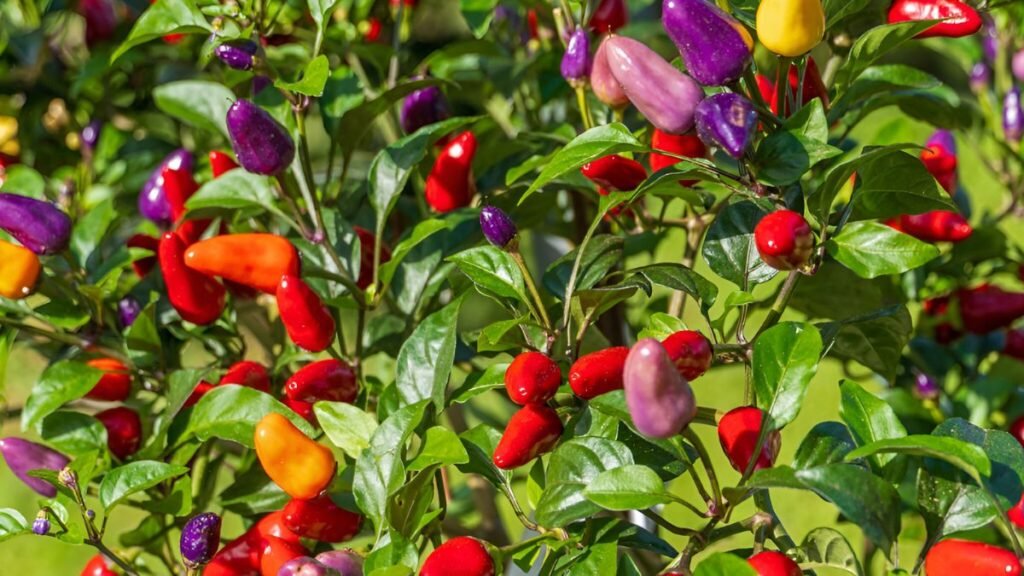The real fun of gardening comes when you not only grow crops, but also fill your garden with colorful views. We need a little color in life, right? So today we will talk about 10 such vegetables, seeing which you will say – “These are flowers, not salad!” But in terms of taste and health, they are no less than any flower. Along with this, we will also know the tips related to their zones, mature size, and care requirements, so that your garden looks blooming in every season.
Eggplant

Eggplant brings a royal look to the garden. When the plant starts bearing fruits, delicate pink or purple flowers bloom on its stem. “When they start bearing fruit, they grow beautiful pink or purple flowers,” says plant expert Lotte Berendsen.
- Zones: 9b to 12a
- Mature size: 2 to 4 feet tall × 1 to 3 feet wide
- Care: Full sunlight; fertile loamy soil
Companion plant with a trap crop:
Lotte recommends planting nasturtiums near your eggplants. These flowers attract pests and repel them from the eggplants, helping to keep your crop healthy.
Tip: After planting the seeds, keep the soil moist, but not waterlogged. Sprinkle with organic fertilizer once a week.
Swiss Chard

Swiss chard is popular for its iridescent stem-like appearance. This vegetable has large, fleshy leaves with red, yellow, orange, or white stems. “I plant it in the corners of garden beds or near the entrance so the pop of color is the first to show,” says Jen McDonald, co-founder of Garden Girls.
- Zones: 2a to 11b
- Mature size: 1 to 2 feet tall by 8 inches to 1.5 feet wide
- Care: Full sunlight; loamy soil
Design tip:
Plant the reddish-white stems of Swiss chard in a pot or border for a vibrant mix of pastel colors in your garden. It does well in light shade, but the color comes out even more in full sun.
Artichoke

Artichokes are living art. Its silvery-veined leaves look like prehistoric trees, and when the thistle-like flower sprouts from the center, a band of blooms appears—splashes of purple. “The leaves look almost prehistoric, and the blooms are a splash of bright purple,” says MacDonald.
- Zones: 7 to 11
- Mature size: 3 to 6 feet tall by 4 to 5 feet wide
- Care: Full sunlight; well-draining soil
Location selection:
If you have plenty of space, grow artichokes directly in the ground. As they spread, your garden will look like an art yard. Once they’re ready, they taste amazing, too.
Chinese Five-Color Peppers

Chinese Five-Color Peppers are a sight to behold and a delight to taste. As the fruits ripen, they are purple at first, then turn creamy, yellow, orange, and finally deep red. “Not all fruits ripen at the same time, so you can have all five colors on the same plant,” explains Lotte Berendsen.
- Zones: 5 to 12
- Mature size: 3 feet tall by 2 feet wide
- Care: Full sunlight; well-drained soil
Plant together:
Plant these peppers with marigolds, petunias, or dwarf sunflowers, which attract beneficial insects and help control pests.
Purple Cauliflower

Purple cauliflower is known for its deep purple color, which results from the presence of antioxidants (anthocyanins). “The color is enhanced with sunlight,” says Macdonald.
- Zones: 2 to 11
- Mature size: 12 to 30 inches high by 12 to 24 inches wide
- Care: Full sunlight; well-draining soil
Garden decoration:
Create a border of small flowers—such as colorful carnations or keyboard flowers—around the cauliflower to make it look more attractive. Kids will love this colorful vegetable and will enjoy eating it, too.
Kale

Kale isn’t just a great addition to a salad; it also gives you a fountain-like look. Its leaves can be stiff or curly, and colors can be blue-green, purple, or red. “It grows from a thick central stem, like a fountain in the garden,” says Macdonald.
- Zones: 7 to 9
- Mature size: 1 to 2 feet tall × 1 to 2 feet wide
- Care: Full sunlight to partial shade; loamy, moist, well-draining soil
Grow together:
Plant colorful pansies under kale, and herbs—like cilantro or mint—also grow well. This brings out the multicolored color.
Squash

Squash displays golden-yellow, star-like flowers among large green leaves that sparkle in the sun. “The large leaves make a beautiful backdrop, and the flowers practically glow,” says Julia Dzafic.
- Zones: 2 to 11
- Mature size: 9 to 18 inches high × 10 to 15 feet wide
- Care: Full sunlight; well-drained soil
Cottage-garden look:
Plant them along the edge of raised beds or trailing among flowers, creating a relaxed, cottage-garden effect. They’re edible, too; these flowers can also be stuffed and lightly fried!
Chives

Chives add wild, untamed beauty to the garden with their delicate, green stems and later-blooming purple, balloon-like flowers. “They are very attractive to pollinators, and you can also cook them and use them for garnishing,” says Dzafik.
- Zones: 3 to 9
- Mature size: 10 to 15 inches tall and wide
- Care: Full sunlight to light shade; loamy to sandy soil
Grow near the kitchen:
Plant chives in the kitchen garden so you can add their fresh, fragrant leaves directly to salads or sauces. Harvest a few leaves now and then for maximum benefit.
Basil

Basil is a kitchen staple and a great addition to your garden. “The glossy green leaves sparkle among flowers and vegetables,” says Dzafiq. When in bloom, the soft white or purple buds add a romantic touch to your garden.
- Zones: 10 to 11
- Mature size: 18 to 24 inches tall and wide
- Care: Full sunlight; well-draining soil
Table centerpiece: If you allow basil to flower rather than picking it off frequently, it makes a perfect centerpiece in a pot and makes a great garnish.
Carrots

Carrots are beautiful not just from their sweet roots hidden underground, but from their fine, soft leaves that spread upward. “Their foliage resembles dill or fennel, giving the garden an effortless, wild vibe,” says Dzafik.
Small Kitchen Design with Attached Living Room
- Zones: 3 to 10
- Mature size: 6 to 12 inches root, 9 inches spread
- Care: Full sunlight to partial shade; loose, well-draining soil
Pathway edging:
Plant wildflowers or herbs alongside carrots, or grow them along path edges. This gives the garden a natural, slightly untamed look.
Conclusion
By growing these ten beautiful and delicious vegetables, you can decorate your garden like a work of art. From the colorful buds of eggplant to the protruding leaves of carrots, you will see nature’s creativity in every direction. Also, these vegetables will provide both nutrition and taste to your food. In limited space or large gardens, adopting these plants can make your garden healthy, colorful, and enjoyable.
FAQs
Q1. What are the ideal soil conditions for growing eggplants?
A1. Eggplants thrive in fertile, loamy soil with good drainage and full sun exposure.
Q2. How can I attract beneficial insects to my garden?
A2. Plant trap crops like nasturtiums or companion flowers such as marigolds and petunias near your vegetables.
Q3. Which zone is best for cultivating purple cauliflower?
A3. Purple cauliflower grows well in USDA zones 2 through 11 with consistent sunlight.
Q4. Can I use squash blossoms in cooking?
A4. Yes, squash blossoms are edible and taste great when stuffed with cheese and lightly fried.
Q5. When should I harvest carrots for optimum sweetness?
A5. Harvest carrots once their tops are about 6–12 inches long and roots reach the desired maturity size.













